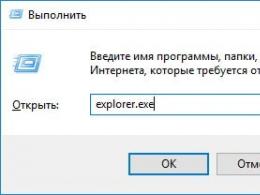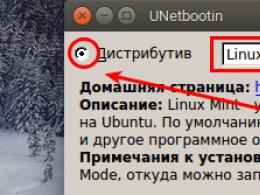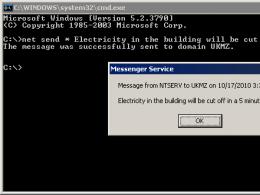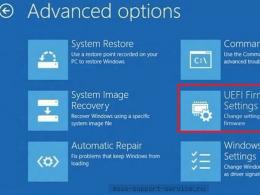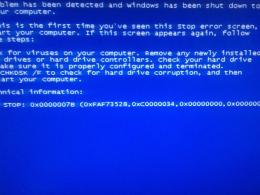The hard drive is not showing up in the bios. What to do if the BIOS sees the HDD, but Windows does not
Wonderful times when no hard drives simply did not exist, have long sunk into oblivion. The development of high technologies differs from others in that it does not obey general laws, but rushes forward like a stratospheric rocket.
Tape drives may have failed more often than modern ones. magnetic disks, but the reasons for their breakdowns were much more understandable. Although ... what are we talking about! No, we do not call everyone to return to the Stone Age. God forbid! We simply give some comparisons, which, according to certain parameters, do not always turn out to be in favor of modern technology.
So you're broke HDD or you suspect that the breakdown lies precisely in it - in the inadequate operation of this complex and obscure device. You are saved if there is another PC near you that sees its own hard drive. Just swap these two disks and make sure that someone else's machine recognizes it as a working one.
If so, then the problem lies in the wrong settings on your system. If the second computer does not see your ill-fated screw, then it is really faulty, and at least it needs to be repaired. As a maximum, just throw it away and replace it with a new one if its surface did not contain some critical data.
We will assume that the screw was detected by another computer and the essence of the problem must be sought in the settings. It happens that the BIOS ( Basic system I / O) does not recognize this or that hardware. In this case, it is usually not recognized by Windows itself. Let's follow this on the example of a hard drive.
BIOS does not see the screw
How to Diagnose this problem? Yes, it's very simple: you need to restart the computer while holding down the special keys to enter the BIOS. Depending on the computer model, this can be either the "Del" key or the "F2" key. Although there may be other options: the PC signals about them at the start, just look at what it displays on the screen at the time the system boots.
Once in the BIOS, you need to go to the "Integrated Peripherals" section and pay attention to the option called "Onboard IDE Controller". If this option is set to "Disabled", then this means that for one reason or another, the BSVV does not see your screw. Here is an explanatory picture:
 Try this:
Try this:
- Carefully check all contacts and connectors, in accordance with the instructions for your "motherboard" and hard drive.
- Remove the system clock battery from the connector and keep it disconnected for 10-15 minutes, after which you can insert it again.
- Set the "Onboard IDE Controller" option to the correct position, i.e. to "Enabled".
If these manipulations fail to revive the screw, contact a specialist.
The BIOS sees the screw, but the OS does not see it
So, we analyze the situation when the BIOS sees, but Windows does not. It's also a pretty common story. The ability to enter an OS recorded on any of the partitions can be affected by the trite boot order set in the same BIOS.
If the first in turn are faulty or unresponsive devices that are physically present in the system, then the boot process may hang.
In this case, you need to go to the BSVV settings and change the download priorities in a direction convenient for the user.
For example, remove a flash drive from the highest priority devices, from which, in principle, it is impossible to boot if it does not contain an image of a certain OS or contains its “broken” image. Here's what the priority window looks like in practice:
 Put the screw in the first place in this list.
Put the screw in the first place in this list.
Other HDD problems
Sometimes the visibility of the device by the operating system is periodic: it is either available or not. The reason for this phenomenon may be a weak computer power supply - replace the unit, and everything will return to normal.
Alternatively, you can disconnect some gluttonous device from the power - this will lead to the same effect. If two disks of the same brand are installed on the same machine, this can also lead to conflicts. Such disks need to be connected and configured in turn.
There is another trick to fixing the situation when the BIOS sees the hard drive, but the Windows OS does not. Open the "Disk Management" snap-in from the "Start" menu => "Control Panel" => "Administrative Tools" and try to "play" with parameters like volume and partition labels. Here is an explanatory drawing for this alternative:
 Well, if none of the above helped, you will have to contact the masters computer repair. It's not that expensive these days.
Well, if none of the above helped, you will have to contact the masters computer repair. It's not that expensive these days.
BIOS does not see the SATA hard drive: instructions for solving the problem
Below is a list of the main problems due to which the BIOS does not see the SATA hard drive. To find out the true cause of the malfunction, it is necessary to carry out a sequential diagnosis of all interconnected nodes of the computer in order to determine their operability.
The hard drive is not set as enabled in the BIOS.
Serial ATA drivers installed incorrectly or not installed at all.
The data cable is damaged or not connected.
The disk drive is not spinning.
The jumpers on the drive case are set incorrectly.
The hard drive is faulty.
First you need to make sure that the device under test is enabled in the BIOS. To do this, you need to enter the settings - at the very beginning of the operating system startup, press the F2 or Del key. Depending on the modification of the system, there may be different options. What exactly do you need to click to enter BIOS settings? The instruction appears at the bottom of the screen when you turn on the computer for a short time. If you skip the period, you will have to turn off the computer again and wait for the moment you enter the settings.
Find a hard drive that is not detected on one of the settings screens and see what is written opposite it. Automatic detection must be set to Automatic. If it says Off. (Off) you need to switch to automatic detection. This problem is typical in cases where a newly installed hard drive with a SATA connection is not detected.
Motherboard drivers not loaded
Problems with installing drivers most often occur when OS Windows is installed on a disk drive that is used as the main boot drive. Then the BIOS does not see the SATA hard drive due to driver problems.
To correctly download and install the drivers, perform the following manipulations:
Download Windows distribution into the DVD drive tray. After that, unplug your computer from the mains.
Insert a SATA hard drive and connect it. Turn on your computer.
During the installation process, you will need to press the F6 key at the appropriate time to start the driver installation process. During the normal installation progress of the system, a screen will briefly appear stating that the missing drivers must be loaded in order for the system to install normally: “Press F6 if you need to install a 3rd party driver”. Try not to miss a moment, otherwise you will have to start all over again.
After a while, an interface for downloading drivers for the SATA controller will appear. Press the S key to continue installation.
To download the drivers, you will need disks with installers, you need to find and download this in advance on the Internet, on the website of the manufacturer of the motherboard that you have installed on your computer.
Data cable failure
Open the system unit and carefully inspect the connected to motherboard and hard drive cables. In the presence of visible mechanical damage the problem is precisely this. Data cables are easily bent, broken, and this leads to a lack of contacts in the connections. It is advisable to check the cable by replacing it with a known working analogue.
Seagate technical services note that the length of the SATA cable does not exceed one meter for normal operation of the devices. It is not uncommon for SATA cables to simply fall out of their connectors due to computer vibration during operation. Check the reliability of the cable connection to the SATA ports.
When connecting loops, be guided by the following conditions:
connector of blue color must be connected to the motherboard controller.
connector gray color serves to connect Slave - an auxiliary hard drive.
The black connector is for the Master - the main drive.
If the cable slave order is reversed, it confuses the BIOS and leads to device identification errors.
Disc not spinning
The Winchester will not be found if it is not receiving power and is not spinning. Outwardly, it is impossible to see the rotation of the disk, it remains to rely on indirect signs.
With the power off, open the system unit, then turn on the computer and listen. With caution, try touching the side wall of the hard drive. If vibration is felt, the disc is spinning.
If nothing is clear, try plugging and unplugging the drive's power cable and compare the sound. To check if the power cable is working, plug it into a DVD drive, where you can see for sure whether the disc is spinning or not.
It is also useful to check whether the installed power supply supplies enough power? It is possible that as upgrades system block power consumption has increased significantly and now there is simply not enough current to maintain the required performance of the equipment.
To make sure that the device under test is working properly, remove it from the tested system unit and install it on a known working computer. If it does not work, the hard drive itself is faulty.
As part of the BIOS tools, there is a function for testing connected drives for operability. Run the test and see the results. If any disk is faulty, it will be clear after the test.
Incorrect jumper settings on the drive case
First you need to check if the jumpers are correctly distributed on the Master-Slave feature. If the same parameters are set on both devices, the BIOS will not be able to detect them correctly.
One of the common problems that computer owners have is when the hard drive is not recognized by their device. It is found on both new PCs and old ones. In this case, the age of the hard drive does not matter, as well as whether it is external or internal.
The first thing to do is to determine the cause of the problem. Sometimes the solution is very simple and the user can fix the problem on their own and get their PC running flawlessly.
There are many problems due to which the hard drive is no longer identified by the device. In most cases, this occurs in the following situations:
- The hard drive is new and is connected for the first time through a parallel (IDE) or serial (SATA) interface.
- Damaged cable or connecting wires.
- The BIOS settings are set incorrectly or it is broken.
- The power supply is low power.
- Installed inefficient cooling system.
- Damaged HDD.
This suggests that you should first diagnose the device in order to identify the cause of the problem and fix it.
If the HDD is connected for the first time, it may operating system did not define it. It may well be absolutely serviceable, but at the same time it will not be shown in the list of local drives.
To fix this, you will need to launch the "Run" dialog box by successively holding the Win and R keys, type the command "compmgmt.msc" and click the "OK" button to execute it.
In the console that appears, select the "Disk Management" section.
In the window that opens, you need to pay attention to the column in the middle. All connected to the device are displayed here. hard drives including conflict. If so, then the problem is in the wrong letter designation.
In order to fix it, you need to right-click on the HDD and select the command that allows you to change the drive letter, and then click on "Change" in the window that appears.
It remains only to select any letter and complete the process using the "OK" button.
In order for the hard drive to work flawlessly in Windows, it should be formatted in NTFS format.
It is done as follows.
- Hold down the Win and R keys to bring up the Run dialog box. Using the "compmgmt.msc" command, you need to go to "Computer Management", and from there - to the "Disk Management" section.
- On the problematic hard drive, you need to right-click and click "Format" in the list of commands that opens.
- In the window that appears, you must select a new format - NTFS and start the process using the "OK" button.
BIOS does not see the hard drive - setup
Sometimes a situation may arise when the order in which the system loads devices is incorrectly set in the BIOS.
In order to change it, you need to go to the BIOS.
During startup, the computer indicates which key is responsible for this action. As a rule, this is Del or F2. This button must be pressed and held during PC startup.
Navigating through the tabs in the BIOS system is done using the arrow buttons, and selection is done with the Enter key.
To change the boot order of connected devices, select the Boot tab. Here, to the priority place (depending on the version, it is designated as 1st Boot Priority or First Boot Device) you need to set the connected hard drive. To save changes and return to the screen Windows boot, you should press F10 and then Y to confirm your action.
To make it easier to fix the error, I advise you to watch the video instruction:
If everything is done correctly, the download will start from the required device.
SATA mode of operation
It is not uncommon for a situation where the BIOS does not have a suitable one for IDE interface Work mode.
The solution is the following.
- Using the F2 or Del buttons pressed when the device is turned on, you must enter the BIOS.
- Now you need to find a setting that, depending on BIOS versions, may be called SATA Operation or OnChip SATA Type, possibly Configure SATA As. It will be located in the Main or Advanced tabs, another option is Integrated Peripherals.
- In the found line, you need to set the value to IDE or Native IDE, press the F10 button to save the new settings and exit the BIOS to the OS boot screen, and then confirm your actions by pressing the Y key.
BIOS does not display hard drive
In the case when the BIOS does not see and, accordingly, does not detect the connected hard drive, this may indicate incorrectly set settings or a failure in them.
Usually wrong installed settings are the result of erroneous actions of the computer owner. The failure that occurred can speak volumes, ranging from power outages to viruses that have infected the operating system installed on the device.
To determine what really happened, you need to pay attention to the system date. If it is installed incorrectly, this indicates a failure has occurred.
You can fix this problem by resetting all settings to factory settings or, in other words, resetting the BIOS.
To do this, you will need to turn off the computer, unplug the power cord from the outlet, and then look at the motherboard and find on it a jumper labeled Clear CMOS, installed on a three-pin connector.
This jumper in the working position is installed on pins 1 and 2, it must be removed and put on pins 2 and 3, then wait 20-30 seconds and return to its original position.
The second way to reset the BIOS to initial state- find the battery installed on the motherboard and pull it out. You can put it in its original place no earlier than half an hour later.
Thus, if the computer does not detect the connected hard drive, it is recommended that you run a device diagnostic for possible problems. In some cases, the problem that has arisen is not significant and the user is quite capable of coping with it on his own, without resorting to expensive specialists.
Facebook Google PlusBIOS does not detect or recognize ATA/SATA hard drive
The BIOS does not detect or recognize the ATA/SATA hard drive.
There are six main reasons why System BIOS may not detect the presence of an internal hard drive. Here is a list of such reasons. They are not ordered, but you can follow the steps here one by one to identify and resolve the issue.
Note. Sections 3, 4, 5, and 6 apply to PC and Mac systems. Sections 1 and 2 only apply to PC systems.
More detailed step by step instructions See Troubleshooting Serial ATA Hard Drives: "Drive Not Detected" for troubleshooting the issues covered in this topic.
If you verify that the ATA or SATA port is set to auto-detect, or the port is enabled, but the system BIOS still does not detect (does not auto-detect) the drive, try to identify/repair the problem by following these steps.
Drive is not spinning
The drive will not spin if it is not receiving power or not receiving enough power. To find out if this is the reason why the hard drive is not detected in the BIOS, do the following:
Turn off your computer.
Open the computer case and disconnect the data cable from the hard drive. After that, power saving commands will no longer be transmitted.
Turn on the system. Check if the hard drive is spinning. Touching lateral side hard drive, you should feel a slight vibration. If you not If you hear or feel no vibrations from the hard drive, it is not running.
If it is not possible to determine if the drive is spinning:
turn on the computer and listen;
turn off the computer;
unplug the computer power cable;
unplug the power cable of the hard drive in question;
reconnect the computer's power cable;
turn on the computer to determine if the sounds of the drive have been heard before; And
then repeat the same steps, now connecting power to the hard drive and listening for the sounds of the drive.
- Connect the power cords to a device such as a CD or DVD drive to ensure that the power cord you are using is in good condition.
- Check your computer's power source to determine if it is providing enough power to run the drives and devices connected to your computer.
- If the drive still does not start spinning, connect it to another computer, if possible.
- Connect the drive to a SATA-USB enclosure or equivalent, if available.
- If all of these steps still do not cause the drive to spin, visit the Warranty Service page to place a warranty replacement order.
- Wrong installation jumper on drive
SerialATA: If you have a SATA 3.0 Gb/s hard drive that is not detected by the SATA 1.5 Gb/s controller or causes a system lock when connected to a SATA 1.5 Gb/s controller, you may need to reduce the speed of the SATA 3.0 hard drive to 1 .5 Gbps for the system to recognize it. For more information on changing the jumper settings to reduce the transfer rate of a SATA hard drive, see this Knowledge Base article.
- (Click to Enlarge) Jumper Settings for Seagate SATA Hard Drives
(Click to Enlarge) Jumper Settings for Seagate SATA Hard Drives
- (Click to Enlarge) Maxtor SATA Hard Drive Jumper Settings
(Click to Enlarge) Maxtor SATA Hard Drive Jumper Settings ATA: For all Seagate ATA hard drives that support the Cable Select jumper setting, it is recommended that you set the Cable Select setting. If your computer was built before October 1998 and does not support UDMA 66 or higher, you will need to use the Master/Slave jumper settings.
-(Click to Enlarge) Seagate ATA Hard Drive Jumper Settings
- (Click to Enlarge) Maxtor ATA Hard Drive Jumper Settings
(Click to Enlarge) Maxtor ATA Hard Drive Jumper SettingsIf the jumper is set to Cable Select on an ATA hard drive, all devices connected to the UDMA cable must also be set to Cable Select. When using the Cable Select jumper setting, the cable determines whether the device is a master or slave device. For more instructions see
Serial ATA motherboard drivers are not loaded properly (especially on Windows XP/2000)
If Windows XP/2000 is installed on a drive that will be used as a boot drive (that is, on the C: drive), then the drive may not be detected during Windows installation. The following are instructions on how to properly perform this procedure:

A few extra notes on using the driver diskette:
In order for the hard drive to be detected when new installation, you need to download the optional SATA controller/motherboard drivers at the beginning of the installation.
The controller/motherboard drivers are either on the included CD or on the manufacturer's website. Seagate does not provide such drivers; these must be obtained from the motherboard manufacturer. Just download necessary drivers floppy disk and keep it handy.
Data cable is broken or disconnected

Good day to all, dear readers! In this article I will try to explain why the BIOS does not see the hard drive - and I will also tell you how to solve such a problem in my article.
This problem, when the hard drive is not detected by the computer, is the most common. It occurs on both old and new computers. It also happens with new and old, external and built-in HDDs.
First, of course, you need to find out the cause of such a problem. Sometimes users can decide everything on their own and get it working with Windows and a laptop hard drive.
Why does the computer not see the hard drive?
I note right away that there are several reasons due to which the hard drive refuses to perform its functions. Such reasons include:
- For the first time, a new sata or ide disk was connected;
- There were problems with the cable or wires;
- Perhaps the BIOS is incorrectly configured or completely out of order;
- Weak power supply;
- Low cooling system;
- The hard drive itself is out of order.
Yes, you need to diagnose, and only then solve the problem. Let's say an inexperienced user will probably have some difficulties with this. Let me help you, and together we will figure out what and how.
The first connection of the hard drive
If this is your first time connecting a screw, then most likely the system simply did not see it. Yes, it is physically in working order, but it is not displayed among local drives.
In order to fix this problem, you need to press Win and R on the keyboard, write compmgmt.msc and select "OK".
Find and select Disk Management.
In the window that appears in the middle, all your connected drives will be identified, including your problem hard drive. As a rule, it is such because of the wrong assigned letter.
Find the required disk and click on it right click mouse, and then select "Change Drive Letter or Drive Path...".

A window will open in which you will have to click on the "Change" button.
Now select the desired letter and select "OK".
Wrong format
For normal functioning drive in Windows, NTFS format is required.
Just like in the instructions above, go to "Disk Management", that is, repeat the previous first two steps. After that, right-click on the disk and select "Format".

Select file system– NTFS, and click OK.
BIOS does not see the hard drive - setting
In some cases, the wrong device priority for booting may be set in the BIOS. When booting the PC, press F2 (or Del). Which key to press will be indicated when the PC starts. By pressing the desired key, you will enter the BIOS.
Please note that due to differences in BIOS versions, the names of menu items hereinafter may differ slightly.
Look for the "Boot" tab. Use arrows to control. Set your HDD to the first place in the list of boot devices (1st Boot Priority/First Boot Device).

Press F10 to save and exit and then press Y to confirm. After that, the PC will boot from the device you set up.
SATA mode of operation
Often, users in the BIOS do not have an operating mode that is compatible with the IDE. In order to make a change, you need to go into BIOS, select Main, Advanced or Integrated Peripherals and find the SATA Operation, Configure SATA As, or OnChip SATA Type setting.

Select IDE or Native IDE, press F10 and type Y.
BIOS does not display hard drive
If the BIOS cannot detect your hard drive, then most likely the problem is incorrect setting or their failures.
Incorrect settings appear due to user actions, and failure can occur for various reasons. So, starting from power outages and ending even with infection of the system. This can be indicated by the system date - if it is not accurate, then you have undoubtedly experienced a failure. To fix this problem, you need to reset all settings.
Look for the Clear CMOS jumper on the motherboard.
Change the jumper from contacts 1-2 to 2-3, hold them for 20-30 seconds and then return to their original position. Besides, there is another way. Find the motherboard in the system unit and remove the battery from it.

You will need to return it back in 25-30 minutes.
Conclusion
Now you know what to do if the BIOS does not see the hard drive. I hope you were able to solve your problem, thank you all for your attention, and don't forget to ask any questions in the comments!

